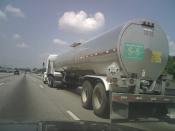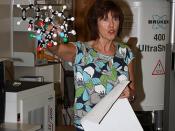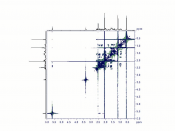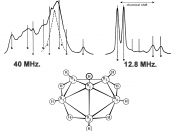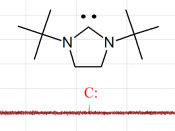Reaction Discovery-EsterificationIntroduction:There are several purposes of this experiment. The first purpose of this experiment is to perform a certain procedure and obtain a product. The second purpose is to make use of IR and NMR spectroscopy. The spectroscopy will be utilized to indentify the starting materials and the product that was obtained during the experiment. The last purpose is to determine the type of reaction that occurred during the procedure.
Compound 1 was found to be methanol. It is the simplest alcohol. It is colorless, flammable, and a liquid with a distinctive odor. At room temperature it is a polar liquid and is used as an antifreeze, solvent, and fuel. Compound B was found to be phthalic acid. Phthalic acid is used mainly in the form of the anhydride to produce other chemicals such as dyes, perfumes, saccharin, phthalates and many others. The reaction that these two compounds went through was esterification.
It is the combination of a carboxylic acid and an alcohol with an acid catalyst to form an ester and water.
Reaction Equation:Experimental Section:To begin the experiment, two materials were obtained. One was labeled with a number, the other with a letter. The numbered product was numbered ÃÂ1ÃÂ and the lettered product was lettered with a ÃÂBÃÂ. A reflux system was set up using a 50 mL round bottom flask. A thermowell sand bath was turned on and the heat was turned to 7. 5.0 grams of compound B (which was a white solid) was added to the 50 mL round bottom flask. Then, 25 mL of compound #1 (which was a clear liquid) and two boiling stones were added to the round bottom flask. 2.5 mL of concentrated sulfuric acid was added, dropwise, into the round bottom flask. As the drops were added, the flask was gently swirled. While adding the sulfuric acid, the flask began to gradually heat up. The flask was then attached to the reflux system and the mixture was refluxed for an hour.
After the reflux system had cooled, the contents of the round bottom flask were poured into a 125 mL beaker that contained 10 mL of distilled water. Two layers began to slowly form. There was an oily looking bubble on the bottom of the beaker, and clear solution on the top. 40 mL of distilled water were gently swirled into the beaker and the clear top layer became cloudy, white.
Once the two layers had completely separated, the bottom oily layer was added to a 125 mL separatory funnel. The separatory funnel was inverted twice and then left to sit for 10 min. After 10 minutes, the solution had completely separated. The oily product on the bottom was drained into a small beaker. Two small scoops of anhydrous sodium sulfate were added to the beaker and the solution sat for about 10 minutes.
The solution was decanted from the anhydrous sodium sulfate and placed into a 10 mL boiling flask. A distillation apparatus was set up. A 5 mL receiving flask was placed onto the distillation apparatus and the boiling flask was heated with a thermowell sandbath that had been heated to a power of 7. Because no liquid distilled into the receiving flask after 10 minutes, the distillation ended and the product in the boiling flask was transferred into a vial. A small amount of anhydrous sodium sulfate was added to the vial and the vial was capped tightly. An IR and NMR were taken of the product. The melting point of B was taken and found to be 210ðC.
Spectra are attached (Figures 1 -6)Table 1a: IR spectra of Compounds 1 and BCompoundPeak (cm-1)InterpretationCompound 1Broad ~3200-OHCompound BBroad 2500-3000R-CO2H (2)~1700C=O of carboxylic acidTable 1b: NMR spectra of Compounds 1 and BCompoundPeak (ppm)SplittingIntegrationInterpretationCompound 1~4.2Singlet3.00O-CH3~4.7Singlet1.00-OHCompound B~7.8Broad singlet1.00R-CO2H~10.5Multiplet2.00Ar-HTable 2a: IR spectrum of productCompoundPeak (cm-1)InterpretationProductSharp ~3000Aromatic stretch1716C=O of ester1433C=C Aromatic ringTable 2b: NMR spectrum of productCompoundPeak (ppm)SplittingIntegrationInterpretationProduct~3.9Singlet3R-O-CH3~7.5 and ~7.7Multiplet1 eachAr-HDiscussion:To determine the identity of the starting materials, an IR and NMR were run on each compound. Referring to Table 1a, compound 1, and Figure 1, there were four indicative peaks that arose in the compoundÃÂs IR spectrum. The broad peak from 3500-3200 cm-1 and the peak around 1030 cm-1 are indicative of the presence of an alcohol. Also, the two sharp peaks around 3200 cm-1 and the peak at 1490 cm-1 indicate that methyl is present. Referring to Table 1b, compound 1, and Figure 2, there were two peaks present in this compoundÃÂs NMR spectrum. There were peaks shown at 4.2 and 4.7 ppm, each a singlet. The integration ratio was a 3:1. The peak at 4.2 is indicative of an OÃÂCH2 group. The second peak indicates that there is an -OH present. The second peak appears farther downfield than the first because of the hydrogen that is attached to the electronegative oxygen. The oxygenÃÂs electronegativity de-shields the hydrogen that is attached to it. It was concluded that compound 1 was methanol.
Referring to Table 1a, compound B, and Figure 3, there were three distinct peaks found on this compoundÃÂs IR spectrum. The peaks from 3000-2500 cm-1 and the peak found at 1700 cm-1 are representative of a carboxylic acid. The peak from 1000-700 cm-1 is indicative of an aromatic ring. In reference to Table 1b, compound B, and Figure 4, there were two distinct peaks found on this compoundÃÂs NMR spectrum. The peak at 7.8 ppm showed up as a broad singlet and the peak at 10.5 ppm was a multiplet. The integration ratio was 1:2. The first peak indicates a carboxylic acid, while the second peak indicates aromatic hydrogen. The second peak appears downfield farther due to the de-shielding of the aromatic ring. The peak also appears as a multiplet because it represents the four hydrogens of the aromatic ring. The peak at 7.8 ppm appears as a singlet because it represents the two carboxylic acids. It was concluded that compound B was phthalic acid. (IR spectrum found on pg. 2667 in volume 2 of IR series and NMR spectrum found on pg. 198 in volume 2 of NMR series.)The final product, dimethyl phthalate was predicted by the reaction. However, to ensure positive identification of the product, an IR and NMR were run. Referring to Table 2a and Figure 5, there were three distinct peaks represented on the IR spectrum. The sharp peak around 3000 cm-1 represents an aromatic ring. The peak at 1433 cm-1 also is indicative of an aromatic ring. This peak, however, represents the C=C bonds within the aromatic ring. The final peak around 1716 cm-1 represents the presence of an ester, caused by the double bond between C and O. By referring to Table 2b and Figure 6, there were two distinct peaks on the NMR spectrum. A singlet was formed at 3.9 ppm and multiplets at 7.5 and 7.7 ppm. The integration ratio was 3:2. The first peak, at 3.9 ppm, is indicative of a methyl group bonded to oxygen. It appears as a singlet because of the equivalent hydrogens present in the methyl group. The second peaks indicate aromatic hydrogen. This peak is farther downfield because the increase of de-shielding of the hydrogens by the aromaticity of the ring. The peak also appears as a multiplet because it represents the four hydrogens of the ring. It was determined that the product of the reaction was in fact dimethyl phthalate.
The sulfuric acid that was added to the methanol and phthalic acid served as the acid catalyst to begin the reaction. A reflux system was used to provide the heat needed to continue the reaction. With the knowledge of the starting materials and the conclusion of the product, it was deduced that the reaction was an esterification, which would produce dimethyl phthalate.
Mechanism:Conclusion:The purpose of this experiment was to follow the given procedure for the unknowns and obtain a product. IR and NMR were then to be used to deduce the starting materials and product of the reaction. The type of reaction and its mechanism was then to be determined, with the starting materials and product that were found. All of these objectives were fulfilled in this experiment. The NMR was helpful in figuring out the structure of the hydrogens for the starting materials and products of the reaction. The IR spectra were helpful in detecting key functional groups for the unknown compounds. The type of reaction was able to be determined through analysis of the types of compounds used and formed (alcohol, carboxylic acid, and ester) and the reagent present in the reaction. It was learned that through Fischer Esterification, methanol and phthalic acid, in the presence of concentrated sulfuric acid, formed a product of dimethyl phthalate.
References:Reaction Discovery Handout, Elizabethtown College Department of Chemistry, MacKay, Revised 8/09Sigma-Aldrich Chemical Library.
